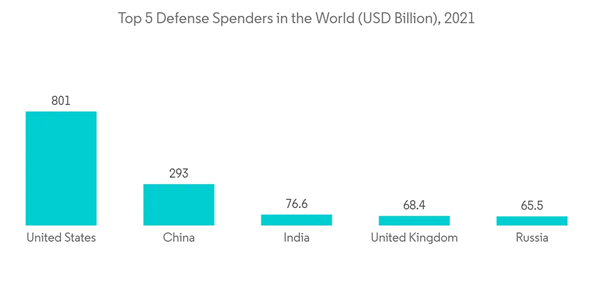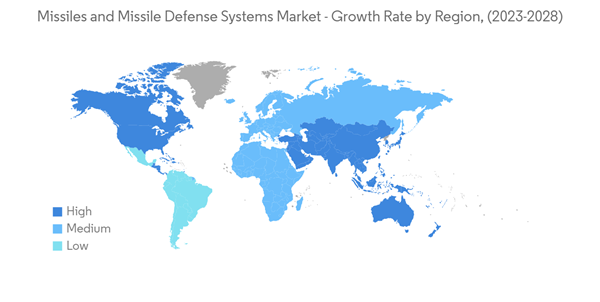The Missiles and Missile Defense Systems Market size is estimated at USD 15.87 billion in 2024, and is expected to reach USD 20.08 billion by 2029, growing at a CAGR of 4.82% during the forecast period (2024-2029).
The impact of COVID-19 on the missiles and missile defense systems market was negligible as the military spending and the investments of armed forces into the procurement of new-generation missiles remained unaffected. An increase in expenditure from several countries and rising procurement of advanced missile defense systems drive the market growth during the pandemic period. Despite the COVID-19 pandemic, global defense expenditure reached over USD 2 trillion in 2021.
The missile market is expected to grow primarily due to the procurement and upgrade activities undertaken by armed forces to counter emerging threats. Several contracts for military aircraft, helicopters, infantry fighting vehicles (IFVs), and armored personnel carriers (APCs) mounted with launchers and warheads are currently underway, and many new contracts are anticipated to be dispersed during the forecast period, creating a parallel demand for countermeasures such as interceptor missiles and missile defense systems.
Several countries are expending significant resources toward augmenting their current military prowess by procuring new weapon systems or modernizing their existing deployed systems with advanced weapons and next-generation missiles. Furthermore, companies are working on developing advanced surveillance systems that may identify incoming stealth threats and intercept them, which is anticipated to boost the market's growth.
The border conflict between China and India and China surrounding India with strategic military bases have also provoked India to invest in short-range missiles to protect the country's waters and birders. As part of the new defense upgrade plans, India has invested in introducing new anti-ship and anti-aircraft short-range missiles in partnership with its own state-run Defense Research and Development Organization (DRDO). In January 2022, the Indian Navy, in partnership with DRDO, successfully tested the short-range, anti-aircraft and anti-ship missile - the Vertical Launch Short Range Surface to Air Missile (VL-SRSAM) that is to be equipped with Indian Naval warships.
With military threats from China, Japan has also increased its investment in defense systems by significant margins in 2022. The new investment of USD 880 million as of December 2021 will be used for conflict deterrence and develop countermeasures against the sophisticated weapons being fielded by The People's Liberation Army (PLA) of China. The country is now planning to upgrade and extend the capability of its cruise missiles to hit objects at 1,000 km, which currently is at just 100 - 200 km, improving the chance to defend against farther adversary targets.
There has been a significant rise in the number of active programs for SCBMs as the countries aim to achieve arsenal superiority over each other. For instance, in August 2021, the Chinese PLA tested a single-stage ballistic missile with new conventional warheads. The newly developed missile is speculated to also feature a multi-mode seeker enabling precision strike capabilities comparable to the Indian Prithvi Missile.
The government is also investing in the development of new missile systems. The country has also been strengthening its attack and defense systems with the increasing threat from its global rival, China. The aggressive military actions from China are also threatening US allies in Asia, further driving the US military to keep the necessary weapons and defense systems at its disposal in bases in Japan and Taiwan. In the wake of the war between Ukraine and Russia, the United States has been alert. The country has been purchasing new missile systems and supplying these weapons to its ally Ukraine to defend against Russia. As part of this, the country, in June 2022, announced the purchase of an advanced medium to long-range surface-to-air missile defense system that is expected to be supplied to Ukraine.
This product will be delivered within 2 business days.
The impact of COVID-19 on the missiles and missile defense systems market was negligible as the military spending and the investments of armed forces into the procurement of new-generation missiles remained unaffected. An increase in expenditure from several countries and rising procurement of advanced missile defense systems drive the market growth during the pandemic period. Despite the COVID-19 pandemic, global defense expenditure reached over USD 2 trillion in 2021.
The missile market is expected to grow primarily due to the procurement and upgrade activities undertaken by armed forces to counter emerging threats. Several contracts for military aircraft, helicopters, infantry fighting vehicles (IFVs), and armored personnel carriers (APCs) mounted with launchers and warheads are currently underway, and many new contracts are anticipated to be dispersed during the forecast period, creating a parallel demand for countermeasures such as interceptor missiles and missile defense systems.
Several countries are expending significant resources toward augmenting their current military prowess by procuring new weapon systems or modernizing their existing deployed systems with advanced weapons and next-generation missiles. Furthermore, companies are working on developing advanced surveillance systems that may identify incoming stealth threats and intercept them, which is anticipated to boost the market's growth.
Missiles Defence System Market Trends
Short Range Missiles Dominated Market Share
Short-range missiles are projected to account for the largest market share during the forecast period. A short-range ballistic missile (SRBM) is a ballistic missile with a range of about 1,000 km (620 mi) or less. Due to their relatively low cost and ease of configuration, they are primarily deployed as a strategic deterrent in regional conflicts. The growing territorial disputes amongst neighboring countries are one of the major drivers of the R&D and production of advanced SRBMs capable of targeting and neutralizing threats at strategic strongpoints in a hostile neighboring country. Furthermore, rising defense expenditure and growing procurement of advanced defense systems drive segment growth.The border conflict between China and India and China surrounding India with strategic military bases have also provoked India to invest in short-range missiles to protect the country's waters and birders. As part of the new defense upgrade plans, India has invested in introducing new anti-ship and anti-aircraft short-range missiles in partnership with its own state-run Defense Research and Development Organization (DRDO). In January 2022, the Indian Navy, in partnership with DRDO, successfully tested the short-range, anti-aircraft and anti-ship missile - the Vertical Launch Short Range Surface to Air Missile (VL-SRSAM) that is to be equipped with Indian Naval warships.
With military threats from China, Japan has also increased its investment in defense systems by significant margins in 2022. The new investment of USD 880 million as of December 2021 will be used for conflict deterrence and develop countermeasures against the sophisticated weapons being fielded by The People's Liberation Army (PLA) of China. The country is now planning to upgrade and extend the capability of its cruise missiles to hit objects at 1,000 km, which currently is at just 100 - 200 km, improving the chance to defend against farther adversary targets.
There has been a significant rise in the number of active programs for SCBMs as the countries aim to achieve arsenal superiority over each other. For instance, in August 2021, the Chinese PLA tested a single-stage ballistic missile with new conventional warheads. The newly developed missile is speculated to also feature a multi-mode seeker enabling precision strike capabilities comparable to the Indian Prithvi Missile.
North America Accounted for Largest Market Share
The North American region currently dominates the market and is expected to continue its dominance over the market during the forecast period. This is primarily due to the highest military spending in the US. The country is robustly investing in procuring and developing new missile and missile defense systems. The FY2022 budget entails USD 20.3 billion and USD 10.9 billion for missiles and munitions and missile defense programs, respectively. Under the Missiles and Munitions budget, the country plans to acquire the Hellfire missiles, Joint Air-to-Surface Missile (JASSM), Joint Direct Attack Munition (JDAM), Long Range Anti-Ship Missile (LRASM), and Standard Missile (SM)-6, whereas, under the Missile Defense programs, the country would procure additional Standard Missile 3 Block IB and IIA missiles, and the Terminal High Altitude Area Defense (THAAD) interceptors.The government is also investing in the development of new missile systems. The country has also been strengthening its attack and defense systems with the increasing threat from its global rival, China. The aggressive military actions from China are also threatening US allies in Asia, further driving the US military to keep the necessary weapons and defense systems at its disposal in bases in Japan and Taiwan. In the wake of the war between Ukraine and Russia, the United States has been alert. The country has been purchasing new missile systems and supplying these weapons to its ally Ukraine to defend against Russia. As part of this, the country, in June 2022, announced the purchase of an advanced medium to long-range surface-to-air missile defense system that is expected to be supplied to Ukraine.
Missiles Defence System Industry Overview
The missile and missile defense systems market is fragmented, with many global and regional players in the market. Some prominent players in the missile and missile defense systems market are The Boeing Company, Lockheed Martin Corporation, Raytheon Technologies Corporation, Northrop Grumman Corporation, and MBDA Inc. The companies are increasing their presence in the market through long-term partnerships and contracts with government agencies and armed forces. For instance, in December 2021, Raytheon Missiles & Defense was awarded a contract worth USD 578 million to manufacture 54 SM-2 Block IIIAZ all-up round upgrades for the US and 215 Standard Missile-2 all-up rounds (SM-2 Block IIIA, IIIAZ, and IIIB variants) for seven partner nations (Chile, Denmark, Japan, the Netherlands, South Korea, Spain, and Taiwan). Furthermore, the companies continuously investing in the research and development of new missiles have been fostering the advancements in accuracy and efficiency of integrated weapon technologies and associated products and solutions of the missiles and missile defense systems.Additional Benefits:
- The market estimate (ME) sheet in Excel format
- 3 months of analyst support
This product will be delivered within 2 business days.
Table of Contents
1 INTRODUCTION
4 MARKET DYNAMICS
5 MARKET SEGMENTATION
6 COMPETITIVE LANDSCAPE
Companies Mentioned (Partial List)
A selection of companies mentioned in this report includes, but is not limited to:
- Raytheon Technologies Corporation
- The Boeing Company
- Lockheed Martin Corporation
- Northrop Grumman Corporation
- MBDA Inc.
- BAE Systems plc
- Tactical Missile Corporation
- Israel Aerospace Industries Ltd.
- ASELSAN A.S.
- Kongsberg Gruppen ASA
- Saab AB
- Rheinmetall AG
- Roketsan A.S.
- Defense Research and Development Organization (DRDO)
Methodology

LOADING...










